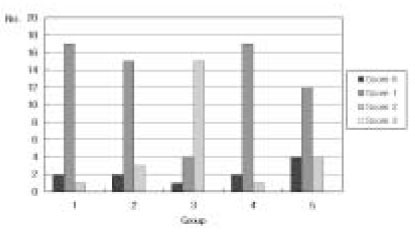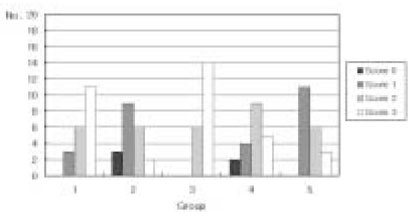J Korean Acad Conserv Dent.
2004 Mar;29(2):162-169. 10.5395/JKACD.2004.29.2.162.
Marginal microleakage of single step adhesives
- Affiliations
-
- 1Department of Conservative Dentistry, College of Dentistry, Chosun University, Korea. ygcho@mail.chosun.ac.kr
- KMID: 1987090
- DOI: http://doi.org/10.5395/JKACD.2004.29.2.162
Abstract
- This study evaluated the marginal microleakage of five single step adhesives. Class V cavity preparations with occlusal margins in enamel and gingival margins in dentin were prepared on both buccal and lingual surfaces of extracted human molar teeth. Prepared teeth were randomly divided into five groups and restored using one of the single step adhesives and composite resins: Prompt L-Pop/Filtek Z-250 (Group 1), AQ Bond/Metafil CX (Group 2), One-Up Bond F/Palfique Toughwell (Group 3), Futurabond/Admira (Group 4), Xeno III/Spectrum TPH (Group 5). The restored teeth were thermocycled. Microleakage was assessed by dye penetration using 2% methylene blue dye solution. The teeth were bisected buccolingually and evaluated for microleakage under steromicroscope. The data were statistically analysed by Kruskal-Wallis test and Mann-Whitney tests. The results of this study were as follows; 1. Microleakage of enamel margins in group 3 was statistically higher than that in groups 1, 2, 4, 5 (p < 0.05). 2. Microleakage of dentin margins in group 1 was statistically higher than that in groups 2, 5, and that in group 3 was statistically higher than that in groups 2, 4, 5 (p < 0.05). 3. Dentin marginal microleakage was higher than enamel marginal microleakage in all experimental groups. In conclusion, Prompt L-Pop showed the least leakage at enamel margin, and AQ Bond showed at dentin margin in this study. Marginal miroleakage in dentin was higher than that in enamel.
Keyword
MeSH Terms
Figure
Cited by 2 articles
-
Comparative bond strength of single step adhesives to different dentinal depths
Young-Gon Cho, Cheol-Hee Jin, Jung-Bum Min
J Korean Acad Conserv Dent. 2005;30(4):319-326. doi: 10.5395/JKACD.2005.30.4.319.Microtensile bond strength of single step adhesives to dentin
Young-Gon Cho, Young-Jae Kee
J Korean Acad Conserv Dent. 2005;30(4):312-318. doi: 10.5395/JKACD.2005.30.4.312.
Reference
-
1. Amaral CM, Hara AT, Pimenta LAF, Rodrigues AL. Microleakage of hydrophilic adhesive systems in class V composite restorations. Am J Dent. 2001. 14:31–33.2. Gladys S, Meerbeek BV, Lambrechts P, Vanherle G. Microleakage of adhesive restorative materials. Am J Dent. 2001. 14:170–176.3. Aguiar FHB, Santos AJS, Groppo FC, Lovadino JR. Quantititive evaluation of marginal leakage of two resin composite restorations using two filling techniques. Oper Dent. 2002. 27:475–479.4. Gagliardi RM, Avelar RP. Evaluation of microleakage using different bonding agents. Oper Dent. 2002. 27:582–586.5. Hannig M, Fu B. Effect of air abrasion and resin composite on microleakage of class V restorations bonded with self-etching primers. J Adhes Dent. 2001. 3:265–272.6. Frankenberger R, Perdigao J, Rosa BT, Lopes M. 'No-bottle' vs multi-bottle' dentin adhesive-a microtensile bond strength and morphological study. Dent Mater. 2001. 17:373–380.
Article7. Inoue S, Meerbeek BV, Vargas M, Yoshida Y, Lambrechts P, Vanherle G. Adhesion mechanism of self-etching adhesives. 1999. In : Advanced Adhesive Dentistry 3rd International Kuraray symposium; 131–148.8. Van Meerbeek B, De Munck J, Yoshida Y, Inoue S, Vargas P, Vijay P, Van Landuyt K, Lambrechts P, Vanherle G. Adhesion to enamel and dentin: Current status and future challenges. Oper Dent. 2003. 28:215–235.9. Swift EJ Jr, Perdigao J, Heymann HO. Bonding to enamel and dentin: a brief history and state of the art, 1995. Quintessence Int. 1995. 26:95–110.10. Balooch M, Wu-Magidi IC, Balazs A, Lundkvist AS, Marshall SJ, Marshall GW, Siekhaus WJ, Kinney JH. Viscoelastic properties of demineralized human dentin measured in water with an atomic force microscope (AFM) based indentation. J Biomed Mater Res. 1998. 40:539–544.
Article11. Walshaw PR, McComb D. Clinical considerations for optimal dentin bonding. Quintessence Int. 1996. 27:619–625.12. Pashley DH, Carvalho RM. Dentine permeability and dentine adhesion. J Dent. 1997. 25:355–372.
Article13. Tay FR, Pashley DH. Aggressiveness of contemporary self-etching systems. I: Depth of penetration beyond dentin smear layers. Dent Mater. 2001. 17:296–308.14. Gordan VV, Vargas MA, Cobb DS, Denehy GE. Evaluation of adhesive systems using acidic primers. Am J Dent. 1997. 10:219–223.15. Miyazaki M, Iwasaki K, Onose H, Moore BK. Enamel and dentin bond strengths of single application bonding systems. Am J Dent. 2001. 14:361–366.16. Van Meerbeek B, Perdigao J, Lambrechts P, Vanherle G. The clinical performance of adhesives. J Dent. 1998. 26:1–20.
Article17. Frankenberger R, Kramer N, Petchelt A. Fatigue behaviour of different dentin adhesives. Clin Oral Investig. 1999. 3:11–17.
Article18. Opdam NJM, Roesters JJM, Feilzer AJ, Verdonschot EH. Marginal integrity and postoperative sensitivity in class 2 resin composite restorations in vivo. J Dent. 1998. 26:555–562.
Article19. da Silva Telles PD, Aparecida M, Machado M, Nör JE. SEM study of a self-etching primer adhesive system used for dentin bonding in primary and permanent teeth. Pediatr Dent. 2001. 23:315–320.20. Nakabayashi N, Saimi Y. Bonding to intact dentin. J Dent Res. 1996. 75:1706–1715.
Article21. Itthagarun A, Tay FR. Self-contamination of deep dentin by dentinal fluid. Am J Dent. 2000. 13:195–200.22. Brackett WW, Covey DA, Germain HA. One-year clinical performance of a self-etching adhesive in class V resin composites cured by two methods. Oper Dent. 2002. 27:218–222.23. Croll TP. Self-etching adhesive system for resin bonding. ASDC J Dent Child. 2000. 176–181.24. Perdigão J, Frankenberger R, Rosa RT. New trends in dentin/enamal adhesion. Am J Dent. 2000. 13:25D–30D.25. Sonoda H, Sasafuchi Y, Kitasako Y, Arakawa M, Otsuki M, Tagami J. Pulpal response to a fluoride-releasing all-in-one resin bonding system. Oper Dent. 2002. 27:271–277.26. Ohno H, Kimura M, Fuchigami S, Oguri M. Dental composition. United states patent number 5,739,177. 1998. 04. 14.27. Kleter GA, Damen JJM, Everts V, Niehof J, Ten Cate JM. The influence of the organic matrix on demineralization of bovine root dentin in vitro. J Dent Res. 1994. 73:1523–1529.
Article28. Nunes MF, Perdigao J, Rosa BT. The effect of an experimental one-application self-conditioning adhesives on microleakage. J Dent Res. 1999. 78:306. (abstract no. 1602).29. Rosa BT, Perdigao J. Bond strengths of nonrinsing adhesives. Quintessence Int. 2000. 31:353–358.30. Li H, Burrow MF, Tyas MJ. The effect of load cycling on the nanoleakage of dentin bonding systems. Dent Mater. 2002. 18(2):111–119.
Article31. Applequist EA, Meiers JC. Effect of bulk insertion, prepolymerized resin composite restorations. Quintessence Int. 1996. 27:253–258.32. Davidson CL, De Gee AJ, Feilzer A. The compositon between the composite-dentin bond strength and the polymerization contraction stress. J Dent Res. 1984. 63:1396–1399.
Article33. Mehl A, Hickel R, Kunzelmann KH. Physical properties and gap formation of light-cured composites with and without: softstart polymerization. J Dent. 1997. 25:321–330.
Article34. Yazici AR, Baseren M, Dayangac B. The effect of flowable resin composite on microleakage in class V cavities. Oper Dent. 2003. 28:42–46.35. Ferrari M, Garcia-Godoy F. Sealing ability of new generation adhesive-restorative materials placed on vital teeth. Am J Dent. 2002. 15:117–128.36. Hofmann N, Siebrecht C, Hugo B, Klaiber B. Influence of curing methods and materials on the marginal seal of class V composite restorations in vitro. Oper Dent. 2003. 28(2):160–167.37. Pontes DG, Melo AT, Monnerat AF. Microleakage of new all-in-one adhesive systems on dentinal and enamel margins. Quintessence Int. 2002. 33:136–139.38. Barnes DM, McDonald NJ, Thompson VP, Blank LW, Shires PJ. Microleakage in facial and lingual class 5 composite restorations: A comparison. Oper Dent. 1994. 19:133–137.39. Pradelle-Plasse N, Nechad S, Tavernier B, Colon P. Effect of dentin adhesives on the enamel-dentin/composite interfacial microleakage. Am J Dent. 2001. 14:344–348.40. Tay FR, King NM, Suh BI, Pashley DH. Effect of delayed activation of light-cured resin composite on bonding of all-in-one adhesives. J Adhes Dent. 2001. 3:207–225.41. Hasegawa T, Manabe A, Itoh K, Wakumoto S. Investigation of self-etching dentin primers. Dent Mater. 1989. 5:408–410.
Article42. Swift EJ Jr, Bayne SC. Shear bond strength of a new one-bottle dentin adhesive. Am J Dent. 1997. 10:184–188.43. Kubo S, Yokota H, Sata Y, Hayashi Y. Microleakage of self-etching primers after thermal and flexural load cycling. Am J Dent. 2001. 14:163–169.44. Tulunoglu O, Uçtaşh M, Alaçam A, Omürlü H. Microleakage of light-cured resin and resin-modified glass-ionomer dentin bonding agents applied with cocure vs pre-cure technique. Oper Dent. 2000. 25:292–298.45. Santini A, Plasschaert AJM, Mitchell S. Effect of composite resin placement techniques on the microleakage of two self-etching dentin-bonding agents. Am J Dent. 2001. 14:132–136.
- Full Text Links
- Actions
-
Cited
- CITED
-
- Close
- Share
- Similar articles
-
- A quantitative analysis about microleakage of all-in-one adhesives
- Microleakage of 2-step adhesive systems in diamond-prepared cavity
- The influence of IRM temporary restorations on marginal microleakage of dentin adhesives
- Microleakage and marginal hybrid layer of dentin adhesives
- Comparison of marginal microleakage between low and high flowable resins in class V cavity



